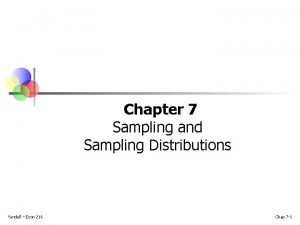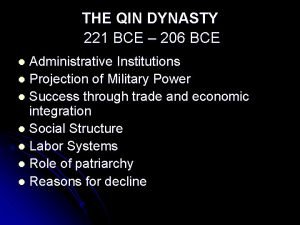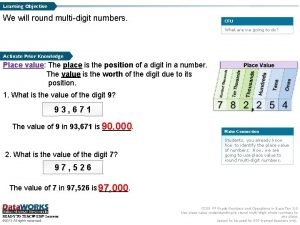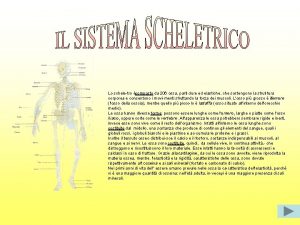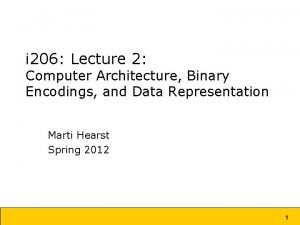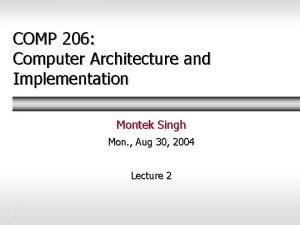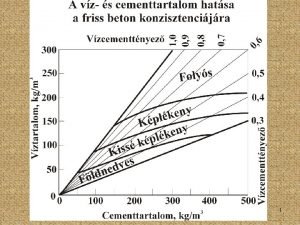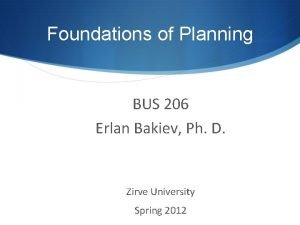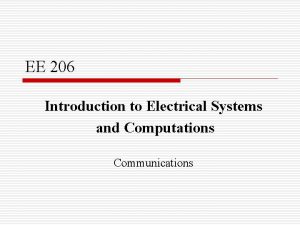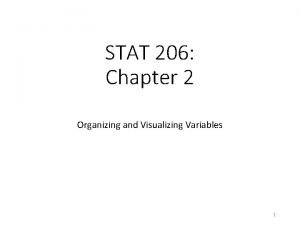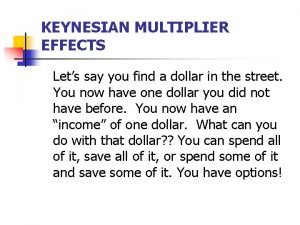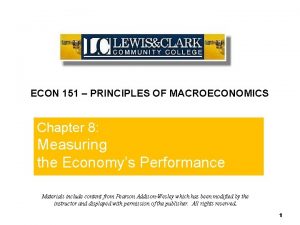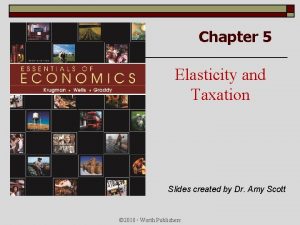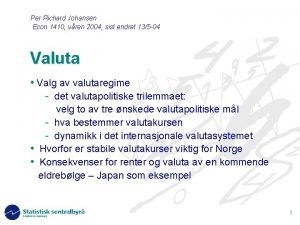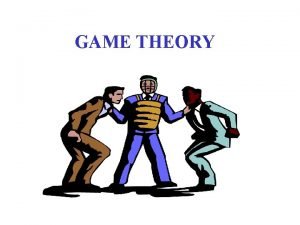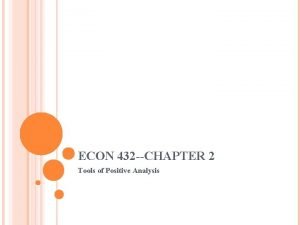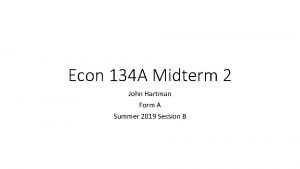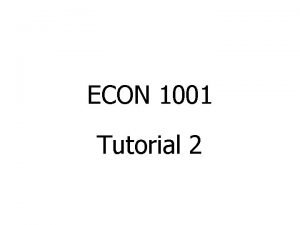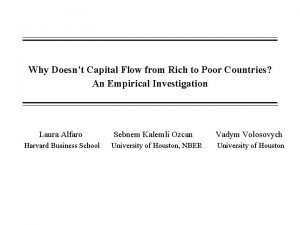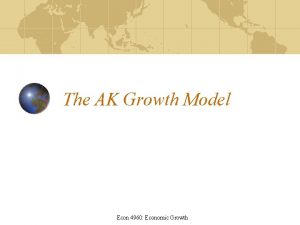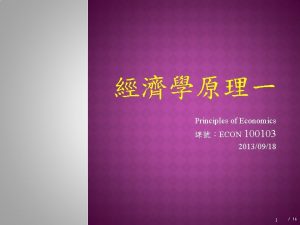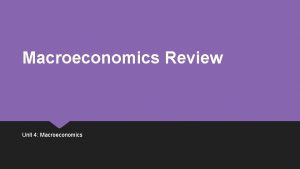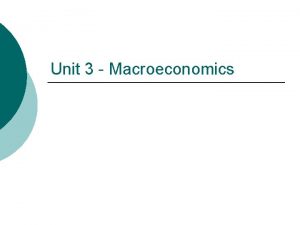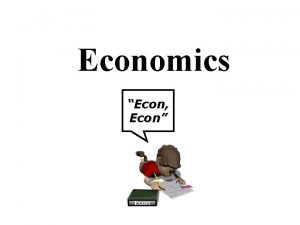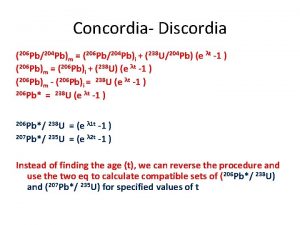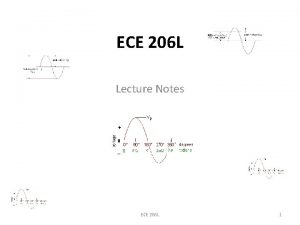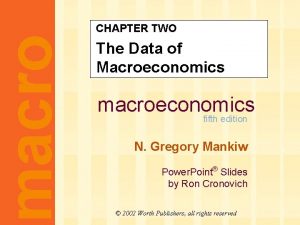ECON 206 Chapter 1 WHAT IS MACROECONOMCS Macroeconomics



















































- Slides: 51

ECON 206 Chapter 1

WHAT IS MACROECONOMİCS ? • Macroeconomics is the study of the behavior of the economy as a whole and the policy measures that the government uses to influence it – • Utilizes measures including total output, rates of unemployment and inflation, and exchange rates Examines the economy in the short and long run Short run : movements in the business cycle – Long run : economic growth – 1 -2

WHAT IS MACROECONOMİCS ? Macroeconomics: aggregates individual markets look at markets as a whole AD and AS Issues include unemployment, economic growth Microeconomics: examines behavior of individual economic units (households, firms) Issues include product and input price determination 1 -3

MACROECONOMİCS IN THREE MODELS • Study of macroeconomics is grounded in three models, each appropriate for a particular time period Very Long Run Model : domain of growth theory focuses on growth of the production capacity of the economy 2. Long Run Model : a snapshot of the very long run model, in which capital and technology are largely fixed • Level of capital & technology determine level of potential output • Output is fixed, but prices determined by changes in AD 3. Short Run Model : business cycle theories • Changes in AD determine how much of the productive capacity is used and the level of output and unemployment • Prices are fixed in this period, but output is variable 1. 1 -4

VERY LONG RUN GROWTH • • • Figure 1 -1 a illustrates growth of income person in the U. S. over last century growth of 2 -3% per year Growth theory examines how the accumulation of inputs and improvements in technology lead to increased standards of living Rate of saving is a significant determinant of future well being and economic growth. 1 -5

THE LONG RUN MODEL • In the long run, the AS curve is vertical and pegged at the potential level of output – Output is determined by the supply side of the economy and its productive capacity – The price level is determined by the level of demand relative to the productive capacity of the economy • Conclusion: high rates of inflation are always due to changes in AD in the long run 1 -6

THE SHORT RUN MODEL • Short run fluctuations in output are largely due to changes in AD – The AS curve is flat in the short run due to fixed/rigid prices, so changes in output are due to changes in AD • Changes in AD in the short run constitute phases of the business cycle – In the short run, AD determines output, and thus unemployment 1 -7

THE MEDİUM RUN • How do we get from the horizontal short run AS curve to the vertical long run AS curve? • The medium run AS curve is tilting upwards towards the long run AS curve position – When AD pushes output above the sustainable level, firms increase prices – As prices increase, the AS curve is no longer pegged at a particular price level 1 -8

THE PHİLLİPS CURVE • Prices tend to adjust slowly AD drives the economy in the meantime • The speed of price adjustment is illustrated by the Phillips curve, which plots the inflation rate against the unemployment rate • In the short run, AS curve is relatively flat, and movements in AD drive changes in prices, output, and unemployment 1 -9

GROWTH AND GDP The growth rate of the economy is the rate at which GDP is increasing Most developed economies grow at a rate of a few percentage points per year. For example, t he US economy grew 2. 1 percent in Q 4 (2019) , the same as in Q 3 and matching forecasts, advance estimates showed. Consumer spending slowed sharply while net trade made the biggest contribution to growth since Q 2 2009 amid a fall in imports. In contrast, negative contributions came from private inventory investment and nonresidential fixed investment. Considering full 2019, the economy advanced 2. 3 percent, the least since 2016 and missing Trump administration's 3 percent target for the second year. Growth in GDP is caused by: 1. Increases in available resources (labor and capital) 2. Increases in the productivity of those resources 1 -10

GROWTH AND GDP Table 1 -1 compares the growth rates of real per capita income across various countries Why do countries like Argentina grow very slowly? Why do countries like China grow very quickly? What policies can raise average growth rates over long periods of time? 1 -11

• The World Bank expects Turkish economy to grow 3% in 2020 and 4% in 2021 and 2022. • Turkey Statistical Institute (TSI) announced the 2019 gross domestic product data for the third quarter. Turkey's economy grew 0. 9 percent in the third quarter. The expectation was 1 percent growth. The Turkish economy contracted 2. 4 percent annually in the first quarter of 2019 and 1. 5 percent in the second quarter. 12

GROWTH RATES OF TURKEY (2017 -2019) 13

GROWTH RATES OF U. S. (2017 -2020) 14

THE BUSİNESS CYCLE AND THE OUTPUT GAP Business cycle: pattern of expansion and contraction in economic activity about the path of trend growth Trend path of GDP is the path GDP production were fully utilized • Deviation of output from the trend is referred to as the output gap would take if factors of – Output gap = actual output – potential output – Output gap measures the magnitude of cyclical deviations of output from the potential level 1 -15

EXAMPE : ACTUAL AND POTENTİAL OUTPUT 1 -16

INFLATİON AND THE BUSİNESS CYCLE The inflation rate can be estimated by the percentage change in the consumer price index (CPI) CPI is a price index that measures the cost of a given basket of goods bought by the average household • If AD is driving the economy, periods of growth are accompanied by increases in prices and inflation, while periods of contraction associated with reduced prices and negative inflation rates 1 -17

INFLATİON AND THE BUSİNESS CYCLE Inflation of 1960 s and 1970 s large increases in price level Price level more than septupled over the 1960 -2009 period On average , something that cost $1 in 1960 cost $7. 76 by 2012 Most of the price increase occurred during the 1970 s 1 -18

NATİONAL INCOME ACCOUNTING Why do we study the national income accounts? 1. 2. Output defined in two ways 1. 2. National income accounting provides formal structure for macrotheory models Introduces statistics that characterize the economy Production side: output = payments to workers (wages), capital (interest and dividends) Demand side: output = purchases by different sectors of the economy Output typically measured as GDP = value of all final goods and services produced within a country over a particular period 2 -19

PRODUCTİON SİDE OF THE ECONOMY The production side of the economy transforms inputs (labor, capital) into output (GDP) Inputs = factors of production Payments to these factors = factor payments The relationship between inputs and outputs defined by the production function where Y = output, N = labor, K = capital “Output is a function of labor and capital, ” where the functional form can be defined in various ways For example: corn = f (land, labor, seed, 2 -20

FROM GDP TO FACTOR PAYMENTS We use the terms output and income interchangeably in macroeconomics are they really equivalent? There a few crucial distinctions between them: 1. Capital wears down over time while it is being used in the production process Net domestic product = GDP – depreciation NDP is the total value of production minus the value of the amount of capital used up in producing that output NDP is usually 87 -89% of GDP 2 -21

FROM GDP TO FACTOR PAYMENTS We use the terms output and income interchangeably in macroeconomics are they really equivalent? There a few crucial distinctions between them: 2. Businesses pay indirect taxes (i. e. taxes on sales, property, and production) that must be subtracted from NDP before making factor payments Factor payments = NDP – indirect business taxes 2 -22

COMPONENTS OF DEMAND Total demand for domestic output is made up of four components: 1. 2. 3. 4. Consumption spending by households (C) Investment spending by firms (I) Government spending (G) Foreign demand for our net exports (NX) The fundamental national income accounting identity is (3) 2 -23

CONSUMPTİON Consumption refers to the purchases goods and services by the household sector of Includes spending on durable (ex. Cars), non-durable (ex. Food), and services (ex. Medical services) Consumption of demand is the primary component 2 -24

GOVERNMENT • Government purchases of goods and services include national defense expenditures and salaries of government employees • Government also makes transfer payments = payments made to people without their providing a current service in exchange § Ex. Social security, unemployment benefits § Transfer payments are NOT included in GDP since not a part of current production § Government expenditure = transfers + purchases 2 -25

INVESTMENT Investment = additions to the physical stock of capital (i. e. building machinery, construction of factories, additions to firms inventories) In the national income accounts, investment associated with business sector’s adding to the physical stock of capital, including inventories Household’s building up of inventories is considered consumption, although new home constructions considered part of I, not C Gross investment included in GDP measure, which is net investment plus depreciation 2 -26

NET EXPORTS Accounts for domestic purchases of foreign goods (imports) and foreign purchases of domestic goods (exports) NX = Exports – Imports Subtract imports from GDP since accounting for total demand for domestic production • NX can be >, <, or = 0 2 -27

Some Identities: A Simple Economy • Assume national income equals GDP use terms income and output interchangeably (convenience) • Begin with a simple economy: closed economy with no public sector output expressed as (4) • Only two things can do with income: consume and save national income expressed as (5), where S is private savings • Combine (4) and (5): (6) • Rearrange (6) s. t. (7), or investment = savings in the simple economy 2 -28

Some Identities: Adding G and NX • When adding the government and the foreign sector, the fundamental identity becomes (8) (Expenditure approach) • Disposable income, YD, is what consumers split between C and S when have a public sector, or (9) , where TR = transfer payments and TA = taxes (10) • If rearrange (9) and substitute (8) for Y, then (11) • Substituting (10) into (11): (12) 2 -29

Some Identities: Adding G and NX • When adding the government and the foreign sector, the fundamental identity becomes (8) • Disposable income, YD, is what consumers split between C and S when have a public sector, or (9) , where TR = transfer payments and TA = taxes (10) • If rearrange (9) and substitute (8) for Y, then (11) • Substituting (10) into (11): (12 ) • Rearranging: (13 ) 2 -30

S, I, GOVERNMENT BUDGET , AND TRADE where G + TR is total government expenditures and TA is government income difference between expenditures and income is the government budget deficit 2 -31

S, I, GOVERNMENT BUDGET , AND TRADE Excess of savings over investment (S > I) in the private sector is equal to the government budget deficit plus the trade surplus Any sector that spends more than it receives in income has to borrow to pay for the excess spending Private sector can dispose of savings in three ways: 1. Make loans to the government 2. Private sector can lend to foreigners 3. Private sector can lend to firms who use the funds for I 2 -32

MEASURİNG GROSS DOMESTİC PRODUCT GDP = value of final goods and services currently produced within a country over a period of time Final goods and services NO DOUBLE COUNTING Ex. Would not include the full price of a car AND the tires bought by the manufacturer for the car tires = intermediate goods 2 -33

MEASURİNG GROSS DOMESTİC PRODUCT GDP = value of final goods and services currently produced within a country over a period of time Goods and services currently (in the time period being considered) produced & excludes transactions involving used goods Ex. Include the construction of new homes in current GDP, but not the sale of existing homes 2 -34

MEASURİNG GROSS DOMESTİC PRODUCT GDP = value of final goods and services currently produced within a country over a period of time Goods and services produced within a country , regardless of the ownership/nationality of the producing firm Ex. Include the sale of a car produced by a Japanese car manufacturer located in Turkey‘s GDP 2 -35

THE FACTOR INCOME APPROACH u u u It consists of employee compensation (wage) , rent, interest, and profits. When we add indirect taxes (less subsidies) and depreciation to nations income, we have GDP = w + r + i + ∏ + indirect (business) taxes+ depreciation - subsidies

EQUALİTY OF EXPENDİTURE AND INCOME Net foreign factor income Net exports Government expenditures Depreciation Indirect taxes-subsidies Inventory adjustment Farm income Investment Interest and investment income Consumption GNP GDP Profits before taxes Wages and salaries (1) Expenditures = (2) Output = (3) Income National Income

OTHER NATİONAL INCOME TERMS Personal income (PI) is national income plus net transfer payments from government minus amounts attributed but not received. PI = NI + transfer payments from government - corporate retained earnings - corporate income taxes – employment taxes

OTHER NATİONAL INCOME TERMS Disposable personal income is personal income minus personal income taxes and payroll taxes. u Disposable personal income is what people have readily available to spend. DPI = PI - personal taxes

PROBLEMS OF GDP MEASUREMENT There are three major criticisms of the GDP measure: 1. Omits non-market goods and services Ex. Work of stay-at-home mothers and fathers not included in GDP 2. No accounting for “bads” such as crime and pollution Ex. Crime is a detriment to society, but there is no subtraction from GDP to account for it 3. No correction for quality improvements Ex. Technological improvements are beneficial to the economy, but nothing is added to GDP to account for them Despite these drawbacks, GDP is still considered one of the best economic indicators for estimating growth in an economy 2 -40

NOMİNAL VS. REAL GDP NGDP is the value of output in a given period measured in current dollars NGDP in 20 19 is the sum of the value of all outputs measured in 20 19 dollars: Changes in NGDP could be purely due to changes in prices if GDP is to be used as a measure of output, need to control for prices 2 -41

NOMİNAL VS. REAL GDP RGDP is the value of output in constant dollars scaled by a based year price, so that any change in GDP is due to change in production, not prices If P B is the price in the base year for good i, RGDP in 20 19 is: vs. 2 -42

INFLATİON AND PRİCES Inflation, , is the rate of change of prices: where P t is today’s price and P price Additionally, is last period’s or today’s price equals last year’s price, adjusted for inflation t-1 If > 0, prices are increasing over time If < 0, prices are decreasing over time inflation deflation How do we measure prices? For the macroeconomy, need a measure of overall prices (price index) Most common indexes are CPI, PPI, and the GDP deflator 2 -43

PRİCE INDEXES : GDP DEFLATOR GDP deflator is the ratio of NGDP in a given year to RGDP of that year Since GDP deflator is based on a calculation involving all goods produced in the economy, it is a widely based price index that is frequently used to measure inflation Measures the change in prices between the base year and the current year Ex. If NGDP in 2012 is $6. 25 and RGDP in 2012 is $3. 50, then the GDP deflator for 2012 is $6. 25/$3. 50 = 1. 79 prices have increased by 79% since the base year 2 -44

PRİCE INDEXES : CPI measures the cost of buying a fixed basket of goods and services representative of the purchases of urban consumers Measure of the cost of living for the average household Differs from GDP deflator in three ways: 1. 2. 3. CPI measures prices of a more limited basket of goods and services (only household goods and services) The bundle of goods in the consumer basket is fixed, while that of the deflation is allowed to vary CPI includes prices of imports, while GDP deflator only considers those goods produced within the Turkey. 2 -45

PRİCE INDEXES : PPI measures the cost of buying a fixed basket of goods and services representative of a firm Captures the cost of production for a typical firm Market basket includes raw materials and semifinished goods PPI is constructed from prices at an earlier stage of the distribution process than the CPI PPI signals changes to come in the CPI and is thus closely watched by policymakers Over long periods of time, the two measures yield similar values and trends for inflation 2 -46

UNEMPLOYMENT The unemployment rate measures the fraction of the workforce that is out of work and looking for a job or expecting a recall from a layoff Important indicator of well-being of an economy/households Optimal unemployment rates differ from country to country Optimal unemployment rate linked to the potential level of output for a given economy. 2 -47

INTEREST RATES AND REAL INTEREST RATES Interest rate = rate of payment on a loan or other investment over and above the principle repayment in terms of an annual percentage Cost of borrowing money OR benefit of lending money Nominal interest rate = return on an investment in current dollars Real interest rate = return on an investment, adjusted for inflation If R is the nominal rate, and r is the real rate, then we can define the nominal rate as: 2 -48

EXCHANGE RATE Each country has its own currency in which prices are quoted In the U. S. prices are quoted in U. S. dollars, while in Canada prices are quoted in Canadian dollars and most of Europe uses the euro Exchange rate = the price of a foreign currency Floating exchange rate price of a currency is determined by supply and demand Fixed exchange rate price of a currency is fixed Ex. A Bermuda dollar is always worth one U. S. dollar 2 -49

T. C. M. B. Exchange Rate (Feb 8, 2020) 50

51
 Econ 206
Econ 206 Econ chapter 7
Econ chapter 7 Chapter 31 open economy macroeconomics
Chapter 31 open economy macroeconomics Macroeconomics chapter 7
Macroeconomics chapter 7 Macroeconomics chapter 8
Macroeconomics chapter 8 Macroeconomics chapter 23
Macroeconomics chapter 23 Ir + a + infinitive (p. 206) answers
Ir + a + infinitive (p. 206) answers Ee 206
Ee 206 Comp 206
Comp 206 221 bce
221 bce Prop 206 pto
Prop 206 pto Csce 206 tamu
Csce 206 tamu Round 787 206 to the nearest ten
Round 787 206 to the nearest ten 206 tl
206 tl Fct beton
Fct beton Ossa coxarum
Ossa coxarum 206 to binary
206 to binary Huesos planos
Huesos planos Comp 206
Comp 206 Comp 206
Comp 206 En 206-1
En 206-1 En 206
En 206 Difference between catabolism and anabolism
Difference between catabolism and anabolism Psir 206
Psir 206 Psir 206
Psir 206 Plan bus 206
Plan bus 206 Ee 206
Ee 206 Seattle utility discount program
Seattle utility discount program Stat 206
Stat 206 Comp 206
Comp 206 Government spending multiplier
Government spending multiplier Fiscal policy ib economics
Fiscal policy ib economics Flip it econ
Flip it econ Econ 151
Econ 151 Mid point formula econ
Mid point formula econ Mps ap macro
Mps ap macro Marginal analysis econ
Marginal analysis econ Econ austria
Econ austria Econ 1410
Econ 1410 Econ 424
Econ 424 Mr darp econ
Mr darp econ Game theory econ
Game theory econ Econ 432
Econ 432 Econ 134
Econ 134 Econ
Econ Esf muni harmonogram
Esf muni harmonogram Gertler econ
Gertler econ Economics velocity formula
Economics velocity formula Econ
Econ Econ
Econ The ak model
The ak model Nthu econ
Nthu econ

